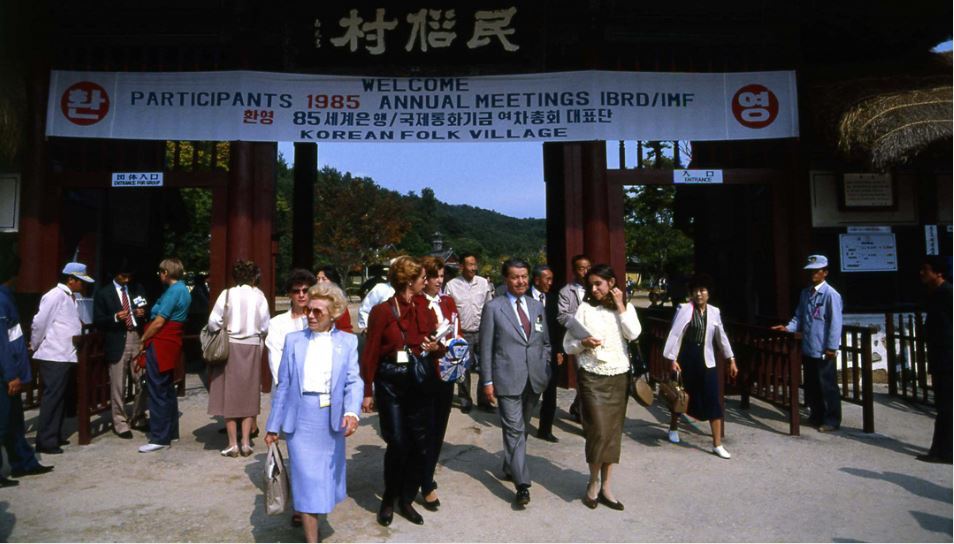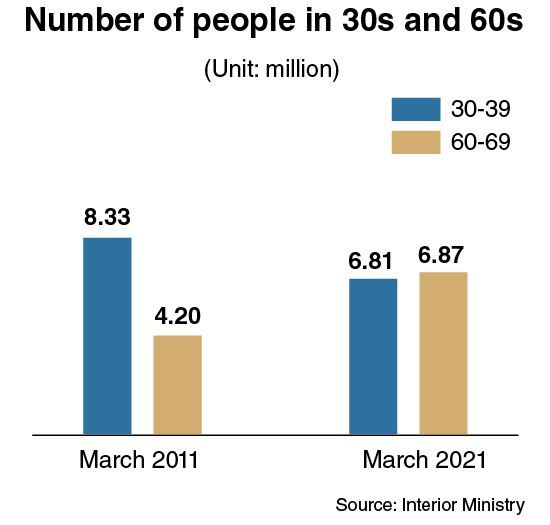[News Focus] 60-somethings outnumber 30-somethings for 1st time
1 in 6 South Koreans are seniors this year
By Kim Yon-sePublished : April 11, 2021 - 14:34

SEJONG -- People in their 60s outnumbered those in their 30s in South Korea for the first time ever this year, state data showed.
According to the Ministry of Interior and Safety, those aged 60-69 outnumbered those aged 30-39 at 6.87 million versus 6.81 million in March.
That put the aged 60-69 category in third place among 11 age groups, from those under 10 to centenarians. The top two groups were people in their 50s (8.61 million) and 40s (8.25 million).
The change can be attributed to more Korean baby boomers, those born between 1955-1963, reaching their 60s.
Ironically, a large portion of those in their 30s, born between 1982-1991, are the children of those in their 60s. The 1980s was one of several decades when the government called for households to limit the number of children they had in the wake of the steep population increase in the 1960s and 1970s.
While those in their 60s outnumbered those in their 20s (6.76 million), the age group far outstripped those age 10-19 (4.76 million) and those aged 0-9 (3.9 million) in March.
These figures have signaled a looming, aggravated social cost burden for elder care, amid a declining “core” working age population in their 20s to 40s.

The situation also pushed up the average age of Koreans to a record high of 43.3 (42.2 for men and 44.5 for women).
In particular, the nation’s demographic history shows that the female population is ageing faster than before. While the average age of female residents stayed at 39.5 a decade earlier in March 2011, it climbed to 41.8 in March 2016.
Amid the pace, their average age is projected to reach 45 in late 2021 or early 2022 and 50 as early as 2028.
As of last month, women residing in South Jeolla Province topped the list among the nation’s 17 major areas at an average age of 48.9, followed by North Gyeongsang Province at 48.3, Gangwon Province at 47.6 and North Jeolla Province at 47.3.
A large portion of the nation’s female seniors live in one of those four provinces, and many are engaged in the farming, fisheries and forestry industry.
Busan, the nation’s second-largest city, ranked fifth at an average age of 46.4, while the average for women in Seoul, the largest city, came to 44.
Women in Sejong were the youngest among the 17 areas, with an average age of 38. It is the only region with an average under 40. Gyeonggi Province, the nation’s most populous area, was the second-youngest at 42.4.
“The youngest regions were that way due to a great number of single-person households and young households in their 20s and 30s have moved to Sejong (the administrative city launched in July 2012) and new residential towns in Gyeonggi Province over the past few years,” a demographic researcher said.
In regards to the “Korean age” system, which counts newborns as being age 1 from birth, Korean women’s average age has already surpassed 45 to approach 46, though the official figure stood at 44.5 legally and based on resident registration, he said.
By Kim Yon-se (kys@heraldcorp.com)
According to the Ministry of Interior and Safety, those aged 60-69 outnumbered those aged 30-39 at 6.87 million versus 6.81 million in March.
That put the aged 60-69 category in third place among 11 age groups, from those under 10 to centenarians. The top two groups were people in their 50s (8.61 million) and 40s (8.25 million).
The change can be attributed to more Korean baby boomers, those born between 1955-1963, reaching their 60s.
Ironically, a large portion of those in their 30s, born between 1982-1991, are the children of those in their 60s. The 1980s was one of several decades when the government called for households to limit the number of children they had in the wake of the steep population increase in the 1960s and 1970s.
While those in their 60s outnumbered those in their 20s (6.76 million), the age group far outstripped those age 10-19 (4.76 million) and those aged 0-9 (3.9 million) in March.
These figures have signaled a looming, aggravated social cost burden for elder care, amid a declining “core” working age population in their 20s to 40s.

The situation also pushed up the average age of Koreans to a record high of 43.3 (42.2 for men and 44.5 for women).
In particular, the nation’s demographic history shows that the female population is ageing faster than before. While the average age of female residents stayed at 39.5 a decade earlier in March 2011, it climbed to 41.8 in March 2016.
Amid the pace, their average age is projected to reach 45 in late 2021 or early 2022 and 50 as early as 2028.
As of last month, women residing in South Jeolla Province topped the list among the nation’s 17 major areas at an average age of 48.9, followed by North Gyeongsang Province at 48.3, Gangwon Province at 47.6 and North Jeolla Province at 47.3.
A large portion of the nation’s female seniors live in one of those four provinces, and many are engaged in the farming, fisheries and forestry industry.
Busan, the nation’s second-largest city, ranked fifth at an average age of 46.4, while the average for women in Seoul, the largest city, came to 44.
Women in Sejong were the youngest among the 17 areas, with an average age of 38. It is the only region with an average under 40. Gyeonggi Province, the nation’s most populous area, was the second-youngest at 42.4.
“The youngest regions were that way due to a great number of single-person households and young households in their 20s and 30s have moved to Sejong (the administrative city launched in July 2012) and new residential towns in Gyeonggi Province over the past few years,” a demographic researcher said.
In regards to the “Korean age” system, which counts newborns as being age 1 from birth, Korean women’s average age has already surpassed 45 to approach 46, though the official figure stood at 44.5 legally and based on resident registration, he said.
By Kim Yon-se (kys@heraldcorp.com)






![[From the Scene] Monks, Buddhists hail return of remains of Buddhas](http://res.heraldm.com/phpwas/restmb_idxmake.php?idx=644&simg=/content/image/2024/04/19/20240419050617_0.jpg&u=20240419175937)







![[From the Scene] Monks, Buddhists hail return of remains of Buddhas](http://res.heraldm.com/phpwas/restmb_idxmake.php?idx=652&simg=/content/image/2024/04/19/20240419050617_0.jpg&u=20240419175937)

![[KH Explains] Hyundai's full hybrid edge to pay off amid slow transition to pure EVs](http://res.heraldm.com/phpwas/restmb_idxmake.php?idx=652&simg=/content/image/2024/04/18/20240418050645_0.jpg&u=20240419100350)

![[Today’s K-pop] Illit drops debut single remix](http://res.heraldm.com/phpwas/restmb_idxmake.php?idx=642&simg=/content/image/2024/04/19/20240419050612_0.jpg&u=)